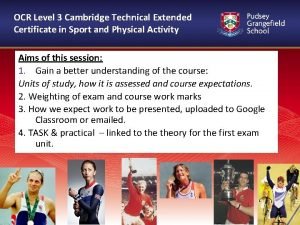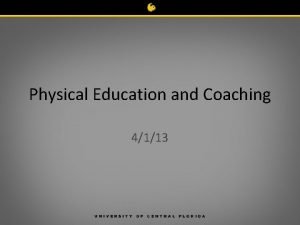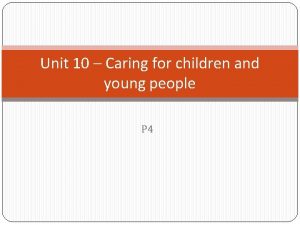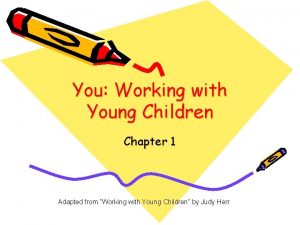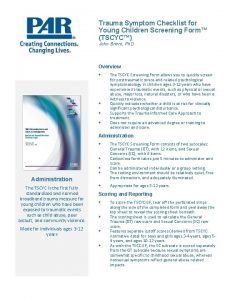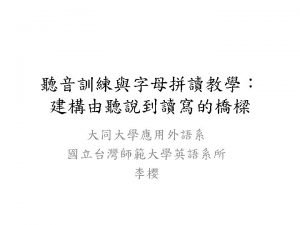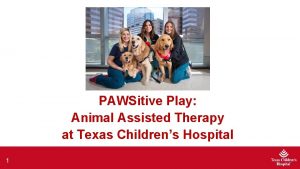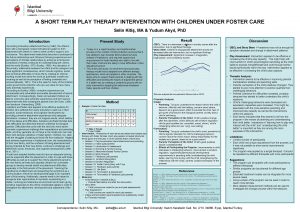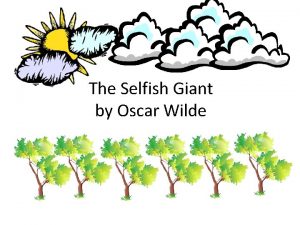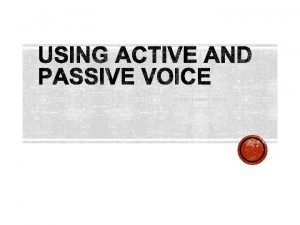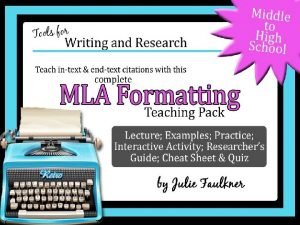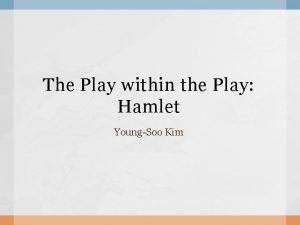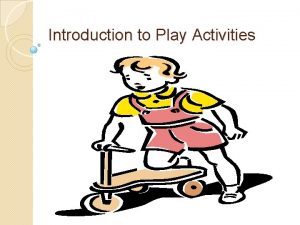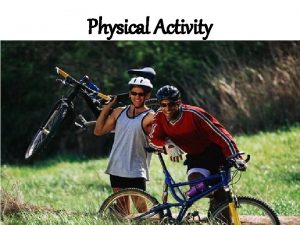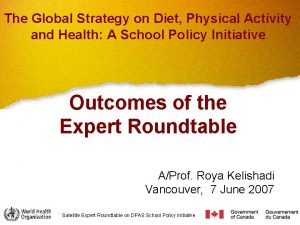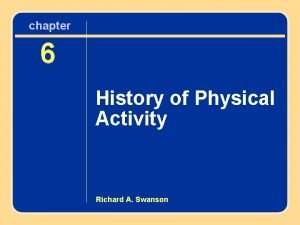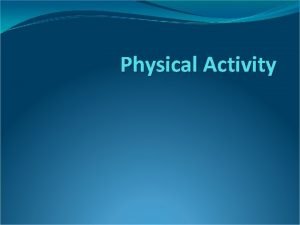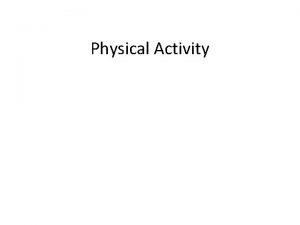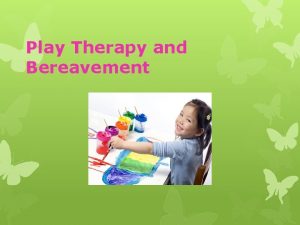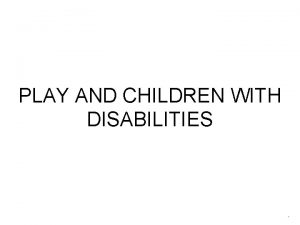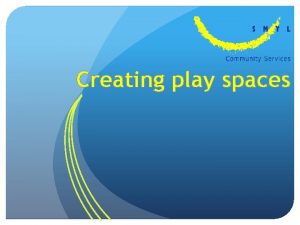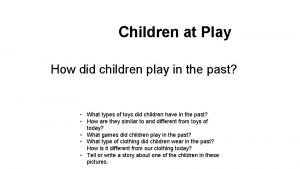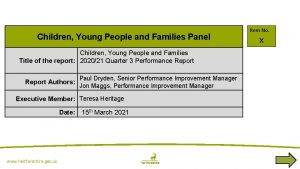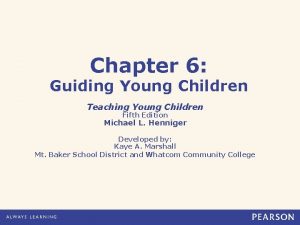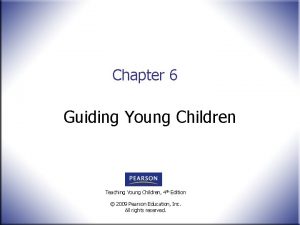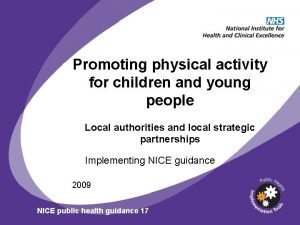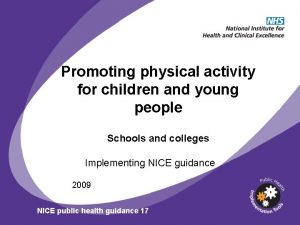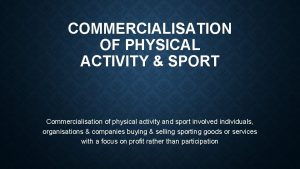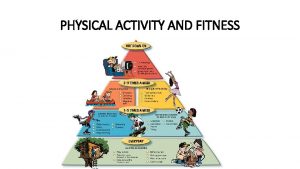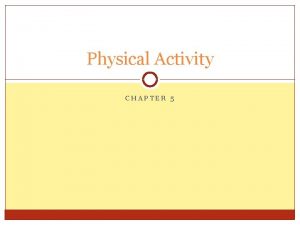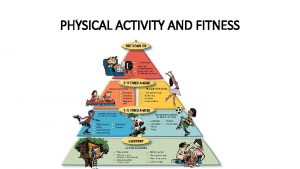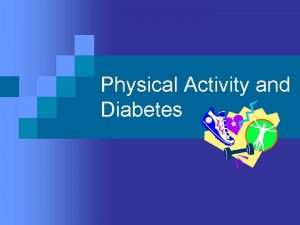Physical activity play and sport in young children























- Slides: 23

Physical activity play and sport in young children: implications for pedagogy Professor Anthony D Okely National Heart Foundation of Australia Career Development Fellow Director, Early Start Research Institute Faculty of Social Sciences University of Wollongong, Australia tokely@uow. edu. au

Outline 1. Behavioural epidemiology framework to provide rationale for promoting physical activity play 2. What are the recommendations around physical activity play? 3. Evidence-based strategies for incorporating physical activity play into early childhood settings?

Physical activity play • Contains characteristics of general play (unstructured, imaginary, child-directed, sometimes spontaneous) but involves movement of large muscles so that there is an appreciable increase in energy expenditure compared with sitting down/resting. • Examples include moving to music, ball activities, water games, rough and tumble play, running and locomotor activities



Health Benefits of Physical Activity Play for Children aged 0 -5 Psychosocial Social and emotional development Motor development Cognitive Executive function Cardiometabolic Blood pressure lipids Insulin resistance Musculoskeletal Bone mineral density Reduced plantar pressure Adiposity 1. Timmons et al. Appl. Physiol. Nutr. Metab. 2012; 37: 773– 792. 2. Okely et al. J Sci Med Sport (under review)

Percent of time spent in MVPA 6% = 47 mins Hnatuik J, Salmon J, Hinkley T, Okely AD, Trost SG, (in press) A review of preschool children’s physical activity and sedentary time using objective measures. Am J Prev Med.

Percent of time spent in LPA 17% = 132 mins Hnatuik J, Salmon J, Hinkley T, Okely AD, Trost SG, (in press) A review of preschool children’s physical activity and sedentary time using objective measures. Am J Prev Med.

Prevalence of PA in 2 -4 year-olds (Australian Recs; ≥ 3 hrs LMVPA/d) 86 81 76 71 66 Average method Every day method 1. ABS. Australian Health Survey: Physical Activity, 2011 -2012. 4364. 0. 55. 004. Accessed 24/7/13.

Tracking of physical activity play Jones RA, Hinkley T, Okely AD, Salmon J. Am J Prev Med 2013; 44(6): 651– 658

Correlates of physical activity play Sex Parent PA Time outdoors Hinkley T, et al. Am J Prev Med 2008; 34(5): 435– 441 Lubans DR, et al. Sports Med 2010; 40 (12): 1019 -1035 Gross motor skills

Efficacy of PA interventions in early years • • • 9 studies; 7 RCTS 3 RCTs no sig diff between groups Results for other 4, all INT>CON Alhassan (2007): 13. 1 CPM Binkley & Specker (2004): 2500 CPD; 1. 5% time in MVPA • Eliakim (2007): 1438 steps/day • Trost (2008) Ward DS, Vaughn A , Mc. Williams C, Hales D. Physical Activity at Child Care Settings: Review and Research Recommendations. Am J Lifestyle Med 2009; 3: 474.

What are the recommendations around physical activity? Australia (2010) • • • Encourage supervised floorbased play from birth 3 hrs/day physical activity spread through the day Should not be sedentary for >1 hr at a time, except for sleeping UK (2011) • • • Encourage supervised floorbased play from birth 3 hrs/day physical activity spread through the day Minimise the amount of time spent being sedentary Canada (2012) • • • Encourage supervised floorbased play from birth 3 hrs/day physical activity spread through the day Minimize the spent being sedentary during waking hours. This includes prolonged sitting or being restrained for more than 1 hr at a time

National physical activity recommendations

Companion statements 1. Mobile infants should be encouraged to be as active as possible in a safe, supervised, minimally structured and nurturing play environment. 2. For toddlers and preschoolers, physical activity should occur primarily through physically active play 3. In selecting activities for children, the emphasis should be on fun and on engaging their interests through exploration, guided-discovery, and unstructured play and developing an enjoyment of outdoor activity. 4. For children 0 -5, competitive sport is developmentally inappropriate and should not be encouraged.

Evidence-based tips on promoting PA Play in ECEC services • • Employ highly trained educators Use indoor space for gross motor activities Provide access to fixed equipment Consider layout of outdoor spaces

Cosco N, Moore R. Preventing Obesity by Design (POD). North Carolina State University. May 2014.

Evidence-based tips on promoting PA Play in ECEC services • • • Employ highly trained educators Use indoor space for gross motor activities Provide access to fixed equipment Consider layout of outdoor spaces Supplement structured/intentional learning with opportunities for related unstructured play

Funded by UOW Small Grant Jump Start • 20 -week 2 -arm cluster pilot RCT • 2 long day care services • • 91 Children aged 3 -5 years Three components, Implemented by setting staff Ø Ongoing professional development (PD) for staff (4 x 30 min PD sessions + 16 demonstration lessons) Ø Ø Ø Structured lessons (20 min each, 3 per week) Ø Ø Control over how program was implemented Sense of accomplishment Fun activities Increased competence in motor skills Pleasing adults (social approval) Unstructured activity sessions Ø Choice for both educators and children in what to participate in

3. Unstructured activities

Results: Physical Activity During intervention Adjusted Difference (95% CI) P value Effect size Counts per minute % SB 110. 48 0. 40 = approx 260. 01 min/day more activity (33. 62, 187. 33) -0. 97 (-5. 76, 3. 82) 0. 69 0. 08 % LPA -0. 06 (-3. 15, 3. 02) 0. 97 0. 01 % MPA -0. 24 (-1. 68, 1. 21) 0. 74 0. 07 % VPA 0. 56 (-0. 90, 2. 02) 0. 16 0. 15 %MVPA 0. 26 (-2. 07, 2. 60) 0. 82 0. 04 Jones RA et al. Pediatric Exercise Science. 2011; 23: 600 -615.

Acknowledgements Marijka Batterham David Lubans Tom Robinson

Thank you Early Start Research Institute, Faculty of Social Sciences University of Wollongong, Australia tokely@uow. edu. au
 Ocr level 3 sport and physical activity
Ocr level 3 sport and physical activity Sports pedagogy definition
Sports pedagogy definition Disadvantages of commercialisation in sport
Disadvantages of commercialisation in sport What is physical fitness test in mapeh
What is physical fitness test in mapeh Unit 10 caring for children and young people
Unit 10 caring for children and young people Working with young children/answer key chapter 1
Working with young children/answer key chapter 1 Tscyc screening form
Tscyc screening form Phonemic awareness in young children
Phonemic awareness in young children Eyfs moodle hampshire
Eyfs moodle hampshire Alcohol consumption causes blood vessels to contract
Alcohol consumption causes blood vessels to contract Texas children's hospital
Texas children's hospital Short-term play therapy for children
Short-term play therapy for children Where did the children go to play every afternoon
Where did the children go to play every afternoon I've got a friend we like to play we play together
I've got a friend we like to play we play together Play random play basketball
Play random play basketball Typewriter types
Typewriter types Hamlet
Hamlet Unit 6 btec sport
Unit 6 btec sport Activity and activity coefficient
Activity and activity coefficient Types of play
Types of play What kind of physical activity
What kind of physical activity Early adulthood physical changes
Early adulthood physical changes Global strategy on diet physical activity and health
Global strategy on diet physical activity and health History of physical activity teaches us about
History of physical activity teaches us about
